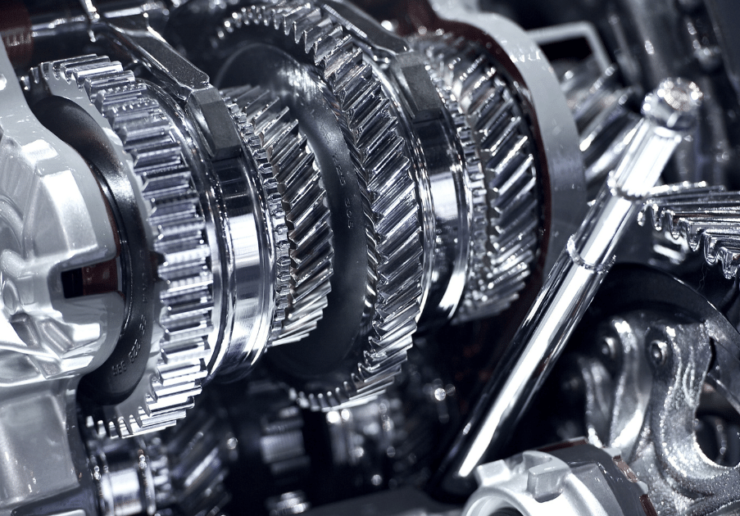1045 is a medium tensile steel that is supplied normalized or hot rolled. Kloeckner Metals routinely supplies 1045 across our 40+ branches nationwide.

1045 steel is a common steel grade because of its combination of higher strength, moderate weldability, and good impact properties. Combined with its high value, you will find 1045 across a wide range of applications.
Already a Kloeckner customer? Shop 1045 steel plate on Kloeckner Direct.
AISI 1045 steel is characterized by good weldability, good machinability, and high strength and impact properties in either the normalized or hot-rolled condition. Because 1045’s chemical composition doesn’t include suitable alloying elements, it does not respond to nitriding.
1045 is most commonly found in the automotive, construction, and agriculture industries.
AISI 1045 is widely used for all industrial applications that require higher wear resistance and strength. Typical applications include gears, pins, rams, shafts, sockets, rolls, axles, spindles, worms, ratchets, light gears, bolts, crankshafts, guide rods, connecting rods, hydraulic clamps, crankshafts, studs, and more.
1045 is considered to have good machinability in either the hot rolled or normalized state. Machine manufacturers may recommend tapping, broaching, drilling, milling, turning, or sawing using suitable tool types, feeds, and speeds to machine 1045.
1045 is characterized by good weldability when normalized or hot rolled. Welding 1045 steel when it is through-, induction-, or flame-hardened, or when tempered, is not recommended. Welding 1045 is recommending under the following conditions:
AISI 1045 can be forged, annealed, normalized, stress-relieved, hardened, and tempered – each of which is explained in more detail below:
Learn more about 4 types of heat treatment that steel can undergo.
AISI 1045 steel is characterized by good weldability, good machinability, and high strength and impact properties in either the normalized or hot-rolled condition. Because 1045’s chemical composition doesn’t include suitable alloying elements, it does not respond to nitriding.
1045 is most commonly found in the automotive, construction, and agriculture industries.
AISI 1045 is widely used for all industrial applications that require higher wear resistance and strength. Typical applications include gears, pins, rams, shafts, sockets, rolls, axles, spindles, worms, ratchets, light gears, bolts, crankshafts, guide rods, connecting rods, hydraulic clamps, crankshafts, studs, and more.
1045 is considered to have good machinability in either the hot rolled or normalized state. Machine manufacturers may recommend tapping, broaching, drilling, milling, turning, or sawing using suitable tool types, feeds, and speeds to machine 1045.
1045 is characterized by good weldability when normalized or hot rolled. Welding 1045 steel when it is through-, induction-, or flame-hardened, or when tempered, is not recommended. Welding 1045 is recommending under the following conditions:
AISI 1045 can be forged, annealed, normalized, stress-relieved, hardened, and tempered – each of which is explained in more detail below:
Learn more about 4 types of heat treatment that steel can undergo.
ANSWER:
1045 has a typical tensile strength between 570 and 700 Mpa and a typical Brinell hardness between 170 and 210 in either the hot rolled or normalized condition.
ANSWER:
While 1045 can be hardened by flame or induction methods, it’s not recommended for other treatments like carburizing or cyaniding.
ANSWER:
1045 is stronger than 1018 thanks to its higher carbon content and tensile strength. The drawback to its higher carbon content is that it’s not as easy to weld. 1045 is usually selected over 1018 wherever higher strength is required, for example in automotive transmission parts.
ANSWER:
1045 has a typical tensile strength between 570 and 700 Mpa and a typical Brinell hardness between 170 and 210 in either the hot rolled or normalized condition.
ANSWER:
While 1045 can be hardened by flame or induction methods, it’s not recommended for other treatments like carburizing or cyaniding.
ANSWER:
1045 is stronger than 1018 thanks to its higher carbon content and tensile strength. The drawback to its higher carbon content is that it’s not as easy to weld. 1045 is usually selected over 1018 wherever higher strength is required, for example in automotive transmission parts.
Steel base plates are fundamental elements employed in various manufacturing processes. These flat, rectangular...
Metal fabrication is a critical process that transforms raw metal materials into finished products....
The solar industry has undergone a significant transformation by incorporating steel products into various...
The unprecedented pace of solar growth is challenging and reforming America’s construction and engineering...
If you’ve got a roof over your head, it’s partly thanks to purlins. A...
Acquiring highly profitable company with annual sales of around USD 30 million Significant expansion...
A stainless steel depot is a specialized facility or supplier that stocks and provides...
American manufacturers use about 28.2 billion pounds of aluminum every year, 41.6% of it...
Leading steel distributor expands commitment to sustainability in the North American market. Kloeckner Metals,...
At Kloeckner, we are excited to announce that our Santa Fe Springs, CA location...

X
The Kloeckner Metals website uses modern technologies. Unfortunately, your browser doesn't support those technologies.
Download the latest version of one of these browsers to experience the site: